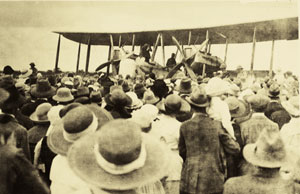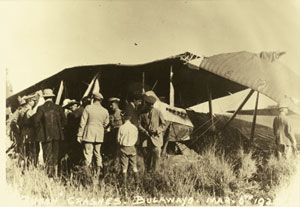Once again, Lord Northcliffe’s Daily Mail came forward to offer an aviation prize after World War I, this time for the first completed flight to Cape Town, South Africa. Starting in late 1918, the British Air Ministry surveyed the area, collecting information on the weather, and identifying and establishing landing sites, some carved out from the jungle.
The success of the transatlantic flight of June 1919 and the epic journey to Australia later that year convinced potential entrants that the Vickers Vimy would be the mount of choice. However, Africa offered different challenges. Chief among them was that most of the route was very hot and very high in altitude, obstacles that would overwhelm the capabilities of the 1920 flying machines. Despite the skills and determination of the pilots, all the competing Vimys were destroyed in crashes along the way.
The South Africa government decided to provide a Vimy to two of the country’s own pilots—Pierre van Ryneveld and C. J. Quintin Brand. This bomber version of the F.B.27 was dubbed the Silver Queen, a name inspired by the dope mixed with aluminum powder that was painted on the plane’s Irish linen covering to reflect the harsh African sun.
 |
|
| A crowd surrounded the Silver Queen II when she arrived in Bulawayo. Courtesy of Philip Jarrett. |
|
| |
|
The Silver Queen departed Brooklands, England, on February 4 and arrived in Libya three days later. The plan was to fly only at night to avoid the intense daytime heat. But on the way to Sudan, a radiator leak caused the plane to overheat at night and necessitated landing early one morning in total darkness. What may have looked like a smooth landing site proved to be a boulder-laden field near the banks of the Nile River. The crew was unharmed, but the plane was unsalvageable, except for the engines and instruments. The South African government arranged with the Royal Air Force in Cairo to make another Vimy available for a second attempt. The engines and instruments, floated down the Nile, were installed in the Silver Queen II.
Van Ryneveld and Brand must have been relieved that their next problems were minor. They managed to fly their Vimy over high altitudes by shedding as much gear as possible and carrying light fuel loads. Taking short hops, they landed in Bulawayo in Zimbabwe on March 5. Determined to reach Pretoria in South Africa, they took on enough fuel to fly 400 miles nonstop. The takeoff from Bulawayo went well, but the weight, the heat, and maybe an ignition fault forced the Silver Queen II to crash just a mile from the airfield.
 |
|
| On departing Bulawayo, the Silver Queen II was unable to remain aloft. The crew survived, but the plane could not be salvaged. Courtesy of Philip Jarrett. |
|
| |
|
Two weeks later, the South African government delivered a small de Havilland D.H.9 biplane. Van Ryneveld and Brand flew the new plane home. The change of planes made them ineligible for the prize. But their arrival in Cape Town on March 20 as the first aviators to fly the length of Africa made them national heroes.
Continued on next page...
|